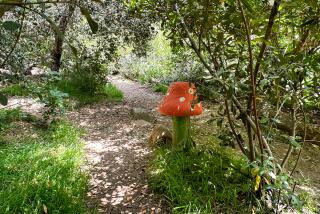A rare survivor
Reports of the death of one of the world’s rarest trees in the Cedar fire that ravaged San Diego County in October have been greatly exaggerated. According to recent news accounts, the Cuyamaca cypress had become extinct in California as a result of the 280,000-acre inferno, but a reconnaissance of Cuyamaca Rancho State Park conducted last month confirmed that 20 to 30 of the trees had survived.
“While the fire burned virtually all of the park, some mature trees have been spared,” said Jim Dice, senior resource ecologist at the park.
Dice was home when he first learned of the history-making blaze. For a time, it was a small fire burning in a semirural area around Ramona, and Dice was only slightly concerned. Cuyamaca was 16 miles away, but 24 hours later, the worst-case scenario occurred. Dice and his colleagues rushed to load up file cabinets and artifacts from the park before the flames arrived.
On the day the fire overtook the park, Dice walked to the top of Cuyamaca Peak and looked down on the conflagration. “It was a wall of smoke and flames running the length of the park, about eight to 10 miles wide,” said Dice. “It was the most impressive thing I had ever seen.”
The Cuyamaca cypress, which grows only in the state park and in a remote area of Baja California, Mexico, has survived many fiery assaults. In fact, fire is so much a part of the ecosystem of eastern San Diego County that most ecologists, like Dice, believe that — except when property and lives are endangered — these burns are a natural part of the life cycle of the chaparral, clearing brush and providing many of the plants with an opportunity to germinate.
The species actually needs fire to reproduce (its cones open only in the presence of intense heat). But the Cedar fire changed this circumstance because it occurred so soon after other fires had swept the region and prevented the trees from maturing.
Losing the cypresses would have been catastrophic. Wandering through a grove in the wild is like wandering through “a primeval world,” said Thomas Oberbauer, environmental resources manager for San Diego County. “It’s unlike anything else in coastal California.”
The cypress is a distant relative of a tree more commonly associated with Iran and Syria. Growing on west-facing slopes at altitudes from 4,000 to 6,000 feet, it is among the rarest of the cypresses, noted for its incense-like odor, its cherry-red and mahogany-brown bark and scale-like leaves. Among botanists, there is debate whether these trees are newly evolved, or whether they are an older species that found refuge here and may have been more widespread in another geologic time.
“Extinction will not happen overnight,” said Dice. “It takes approximately 50 years for a cypress to mature and reach its reproductive ability. The concern is that if a fire comes through every 10 years, the teenage trees that don’t reach reproductive capacity will be wiped out.” For Oberbauer, the key issue is to keep the trees from burning again. “We need to create a vegetation mosaic to protect the area, a buffer utilizing prescribed fires, so they don’t get burned,” he said.
Although Dice is relieved that some of the cypresses survived, he knows that the park, which is closed to the public, has been radically changed by the firestorm. “The sad part is that this is a place where all of us in San Diego went,” he said. “It’s not going to look like a mature forest in my lifetime. My son will hopefully one day see Cuyamaca as I saw it.”







